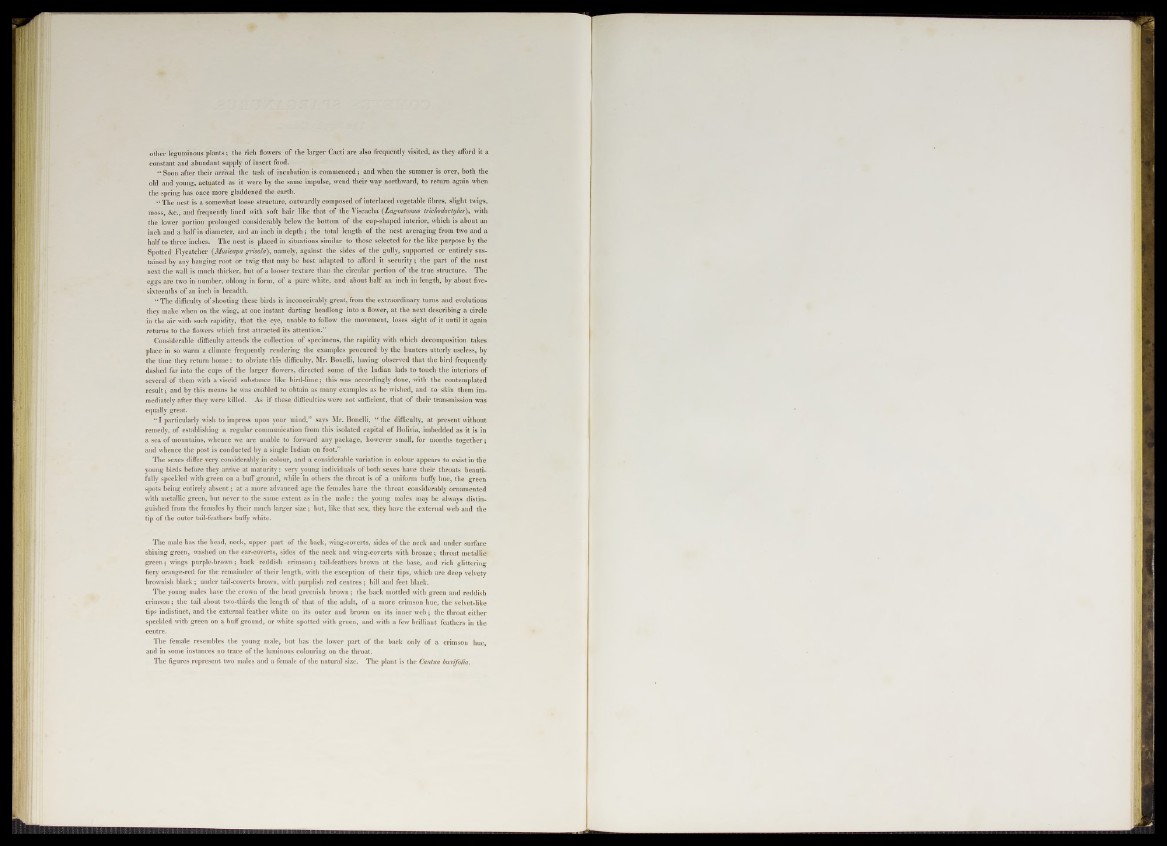
other leguminous plants; the rich flowers of the larger Cacti are also frequently visited, as they afford it a
constant and abundant supply of insect food.
“ Soon after their arrival the task of incubation is commenced; and when the summer is over, both the
old and young, actuated as it were by the same impulse, wend their way northward, to return again when
the spring has once more gladdened the earth.
“ The nest is a somewhat loose structure, outwardly composed of interlaced vegetable fibres, slight twigs,
moss, See., and frequently lined with soft hair like that of the Viscacha (Lagostomus trichodactylus), with
the lower portion prolonged considerably below the bottom of the cup-shaped interior, which is about an
inch and a half in diameter, and an inch in depth; the total length of the nest averaging from two and a
half to three inches. The nest is placed in situations similar to those selected for the like purpose by the
Spotted Flycatcher (Musicapa grisola), namely, against the sides of the gully, supported or entirely sustained
by any hanging root or twig that may be best adapted to afford it security; the part of the nest
next the wall is much thicker, but of a looser texture than the circular portion of the true structure. The
eggs are two in number, oblong in form, of a pure white, and about half an inch in length, by about five-
sixteenths of an inch in breadth.
“ The difficulty of shooting these birds is inconceivably great, from the extraordinary turns and evolutions
they make when on the wing, at one instant darting headlong into a flower, at the next describing a circle
in the air with such rapidity, that the eye, unable to follow the movement, loses sight of it until it again
returns to the flowers which first attracted its attention.”
Considerable difficulty attends the collection of specimens, the rapidity with which decomposition takes
place in so warm a climate frequently rendering the examples procured by the hunters utterly useless, by
the time they return home: to obviate this difficulty, Mr. Bonelli, having observed that the bird frequently
dashed far into the cups of the larger flowers, directed some of the Indian lads to touch the interiors of
several of them with a viscid substance like bird-lime; this was accordingly done, with the contemplated
result; and by this means he was enabled to obtain as many examples as he wished, and to skin them immediately
after they were killed. As if these difficulties were not sufficient, that of their transmission was
equally great.
“ I particularly wish to impress upon your mind,” says Mr. Bonelli, “ the difficulty, at present without
remedy, of establishing a regular communication from this isolated capital of Bolivia, imbedded as it is in
a sea of mountains, whence we are unable to forward any package, however small, for months together;
and whence the post is conducted by a single Indian on foot.”
The sexes differ very considerably in colour, and a considerable variation in colour appears to exist in the
young birds before they arrive at maturity: very young individuals of both sexes have their throats beautifully
speckled with green on a buff ground, while in others the throat is of a uniform bufly hue, the green
spots being entirely absent; at a more advanced age the females have the throat considerably ornamented
with metallic green, but never to the same extent as in the male: the young males may be always distinguished
from the females by their much larger size; but, like that sex, they have the external web and the
tip of the outer tail-feathers buffy white.
The male has the head, neck, upper part of the back, wing-coverts, sides of the neck and under surface
shining green, washed on the ear-coverts, sides of the neck and wing-coverts with bronze; throat metallic
green; wings purple-brown; back reddish crimson; tail-feathers brown at the base, and rich glittering
fiery orange-red for the remainder of their length, with the exception of their tips, which are deep velvety
brownish black; under tail-coverts brown, with purplish red centres; bill and feet black.
The young males have the crown of the head greenish brown; the back mottled with green and reddish
crimson; the tail about two-thirds the length of that of the adult, of a more crimson hue, the velvet-like
tips indistinct, and the external feather white on its outer and brown on its inner web; the throat either
speckled with green on a buff ground, or white spotted with green, and with a few brilliant feathers in the
centre.
The female resembles the young male, but has the lower part of the back only of a crimson hue,
and in some instances no trace of the luminous colouring on the throat.
The figures represent two males and a female of the natural size. The plant is the Cantua buwifolia.